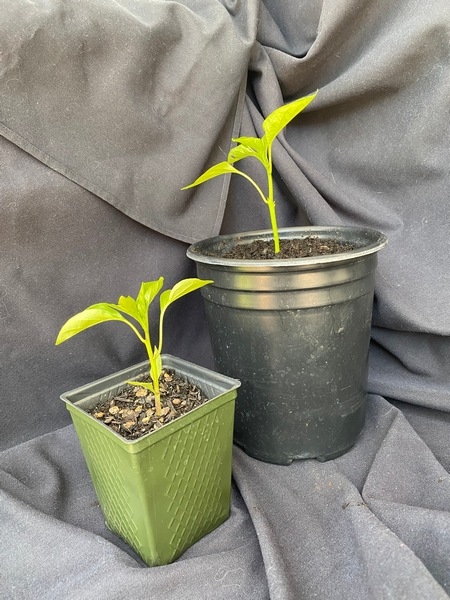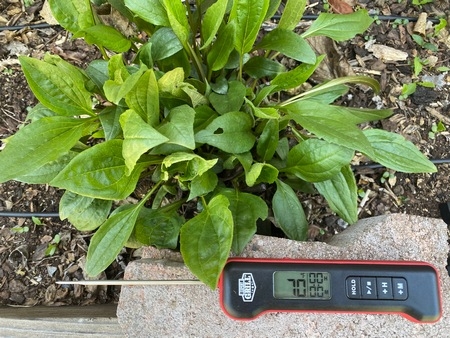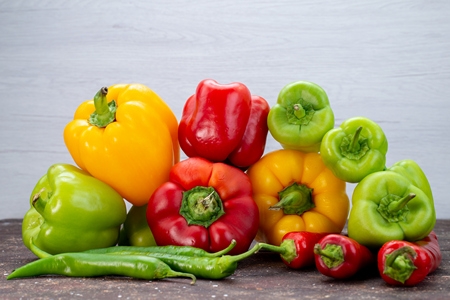One of the comments we often hear as Master Gardeners is “My pepper plants grow but I get only a few small peppers or no peppers at all”. After a couple of frustrating years many gardeners stop growing peppers altogether. Peppers are a nutritional powerhouse as well as a rainbow of color, and they deserve a place in the garden. With attention to a few details, you can grow a “peck” of peppers and add a burst of color to your garden and your dinner plate.
While peppers are not hard to grow, they are quirky in a few areas.
The first quirky factor concerns cold soil temperatures at planting. Peppers do not like to have their roots in cold soil. Chilly soil causes peppers to go dormant Even when the soil warms, peppers may not fully recover, resulting in little or no fruit set. To prevent this, the minimum soil temperature for planting pepper is 70°F. The soil temperature should be taken early in the morning at a depth of 4–6” where the root ball is going to rest. Containers will reach 70°F first, raised beds will be a couple of weeks later, and in-ground beds will be the last to warm. Depending on how early you purchase your plants you may need to move them up into larger pots. One-gallon pots work well and will give the pepper roots plenty of growing space.
The second quirky factor is nighttime temperatures below 60°F. At this temperature peppers slow their development and at 55°F peppers may drop their flowers altogether. To prevent this, you can use polyethylene plastic tunnels, pulling the plastic over the peppers in the late afternoon to capture some additional heat when overnight temperatures are expected to be chilly. Instructions for DIY row covers and poly tunnels are in the link below.
The third quirky factor concerns heat. When the daytime temperature goes over 85°F, pepper pollen begins to shut down, at 90°F and above peppers often drop their blooms. To prevent this, we recommend putting shade cloth over your peppers on high temperature days. In addition to keeping the temperature cooler, the shade cloth is a great help in preventing sunscald on peppers.
Shade cloth comes in two types, woven and knit (lockstitch); we have found knit shade cloth works best and is resistant to rips, tears, and fraying. Shade cloth comes in percentages of shade provided. Choose one between 30%–50% for garden shading. You can find shade cloth in pre-cut panels or bulk rolls of various widths and lengths. To make sure you order the correct width, measure from ground level to ground level over the top of the hoops from side to side. Repeat this measuring process from one end of the frame to the other end of the frame to give the length. A simple frame using PVC pipe and 24” lengths of rebar (or pipe clamps) are quick and easy to assemble. This link will walk you through the process.
https://ucanr.edu/sites/ucmgnevada/files/333484.pdf
Although the following information is not vital, we have found these practices to be beneficial:
- Peppers are shallow rooted so a 2-inch layer of mulch will help keep the soil temperature cooler and the soil moisture consistent.
- Prep the soil with 2 inches of compost and a low nitrogen starter fertilizer; work gently into the top of the soil.
- Transplant peppers in the cool of the day, spacing them 18–24 inches apart to allow for good airflow. Peppers dislike having their roots disturbed; handle them carefully.
- Peppers do not tolerate overly wet or overly dry conditions. Keep peppers consistently watered especially during flowering and fruit set.
- High nitrogen feeding can result in low fruit yield. Place a side-dressing of aged compost or worm castings around pepper plants when the first flowers appear or feed with an organic low nitrogen fertilizer. Continue to feed lightly at 3–4-week intervals.
- Peppers appreciate additional mineral supplements of calcium, phosphorus, and magnesium as they are setting blooms.
If you pay attention to these three vital areas—cold soil, cold night temps, and high daytime temps—you will go a long way toward harvesting that “peck” of peppers. Take care to use the best practices and you'll be pleased with your results. The bounty of your garden will be a delight and treat for your friends and family.
Help Desk of the UC Master Gardeners of Contra Costa County (BHD)


